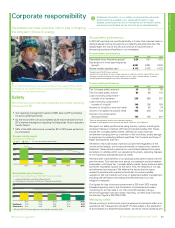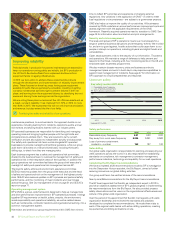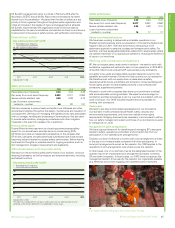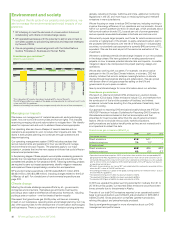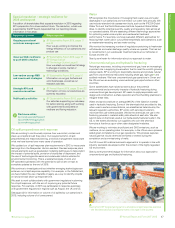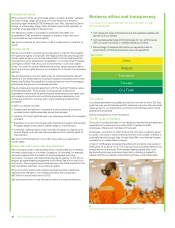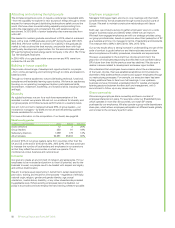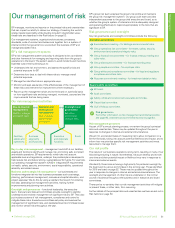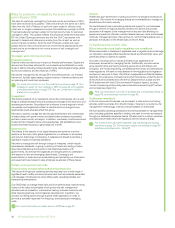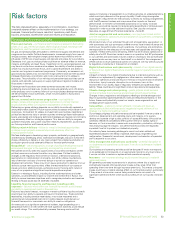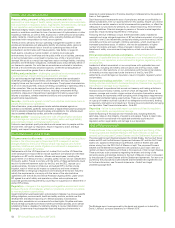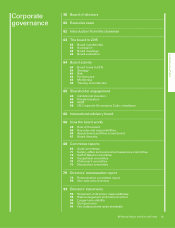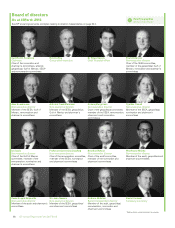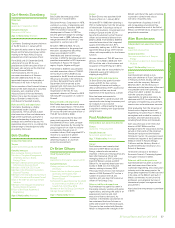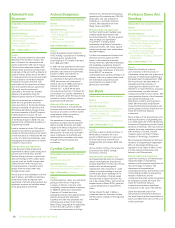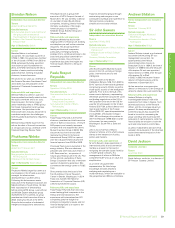BP 2015 Annual Report Download - page 53
Download and view the complete annual report
Please find page 53 of the 2015 BP annual report below. You can navigate through the pages in the report by either clicking on the pages listed below, or by using the keyword search tool below to find specific information within the annual report.
We take steps to identify and correct areas of non-conformance and take
disciplinary action where appropriate. In 2015 our businesses dismissed
132 employees for non-conformance with our code of conduct or
unethical behaviour (2014 157, 2013 113). This excludes dismissals of staff
employed at our retail service stations.
See bp.com/codeofconduct for more information.
In addition to our code of conduct, we have policies on a variety of related
issues, including anti-bribery and corruption, political donations and
human rights.
Anti-bribery and corruption
Bribery and corruption are significant risks in the oil and gas industry. We
have a responsibility to our employees, our shareholders and the countries
and communities in which we do business to be ethical and lawful in all
our dealings. Our code of conduct explicitly prohibits engaging in bribery
and corruption in any form.
Our group-wide anti-bribery and corruption policy applies to all BP-
operated businesses. The policy governs areas such as the inclusion of
appropriate clauses in contracts, risk assessments and training. We
provide training to those employees for whom we believe it is most
relevant, for example, depending on the nature or location of their role or
in response to specific incidents.
Lobbying and political donations
We do not use BP funds or resources to support any political candidate or
party. Employees’ rights to participate in political activity are governed by
the applicable laws in the countries in which we operate. For example, in
the US, BP provides administrative support to the BP employee political
action committee (PAC) to facilitate employee involvement and to assess
whether contributions comply with the law and satisfy all necessary
reporting requirements.
Tax and financial transparency
BP is committed to complying with tax laws in a responsible manner and
to having open and constructive relationships with tax authorities. BP
supports efforts to increase public trust in tax systems. We engage in
initiatives to simplify and improve tax regimes to encourage investment
and economic growth.
BP will start to disclose information on payments to governments on a
country-by-country and project basis in 2016. The disclosure is required
under the revenue transparency provisions contained in the EU
Accounting Directive, which was recently brought into effect in UK law.
We are awaiting the finalization and adoption of SEC rules under the US
Dodd-Frank Act.
As a founding member of the Extractive Industries Transparency Initiative
(EITI), BP works with governments, non-governmental organizations and
international agencies to improve transparency and disclosure of
payments to governments. We support governments’ efforts towards
EITI certification in countries where we operate and have worked with
many countries on implementation of their EITI commitments, including
Australia, Azerbaijan, Indonesia, Iraq, Norway, Trinidad & Tobago, the UK
and US.
See bp.com/tax for BP’s approach to tax.
Employees
BP’s performance depends on having a highly skilled,
motivated and talented workforce that reflects the diversity of
the societies in which we operate.
• Our goal is to create an environment of inclusion where our people are
treated with respect, dignity and without discrimination.
• We aim to develop the capabilities of our workforce with a focus on
the skills required to maintain safe and reliable operations.
• We are reducing activity in response to the current low-oil price
environment and some of this has resulted in job losses.
An employee at our service station in Twyford, UK. We are increasing the
footprint of our retail presence in many European countries and actively
recruiting in these markets.
BP employees
Number of employees at 31 Decembera 2015 2014 2013
Upstream 21,700 24,400 24,700
Downstream 44,800 48,000 48,000
Other businesses and corporate 13,300 12,100 11,200
Total 79,800 84,500 83,900
Service station staff 15,600 14,400 14,100
Agricultural, operational and
seasonal workers in Brazil 4,800 5,300 4,300
Total excluding
service station staff
and workers in Brazil 59,400 64,800 65,500
a Reported to the nearest 100. For more information see Financial statements – Note 34.
We aim to develop the capabilities of our workforce with a focus on the
skills required to maintain safe and reliable operations. As we adapt to the
current low oil price environment, we are reducing activity and simplifying
the way we work. Some of this has resulted in job losses. Our employee
headcount at the end of 2015 was 4,700 lower than the previous year.
Our total upstream workforce – including employees and contractors – is
now 20% smaller than it was in 2013, with a reduction of around 4,000
expected in 2016. We are aiming for an upstream workforce of approximately
20,000 by the end of 2016. We expect to reduce our downstream workforce
roles by more than 5,000 by the end of 2017 compared with 2014, excluding
service station staff and the reallocation of around 2,000 global business
services staff from Downstream to Other businesses and corporate in 2015.
By the end of 2015, we had already achieved a reduction of more than 2,000.
The group people committee, chaired by the group chief executive, has
overall responsibility for key policy decisions relating to employees and
governance of BP’s people management processes. In 2015 the
committee discussed longer-term people priorities, reward, progress in
our diversity and inclusion programme, employee engagement, and
improvements to our training and development programmes.
BP Annual Report and Form 20-F 2015 49
Strategic report






